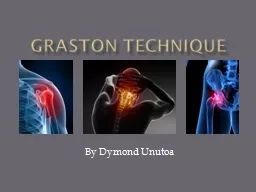

Objectives Know what Graston technique GT is Understand the history of Graston technique Be able to recognize Graston tools and understand the purpose behind each ones design Understand the purpose of GT and its effects ID: 778785
Download The PPT/PDF document "GRASTON TECHNIQUE By Dymond Unutoa" is the property of its rightful owner. Permission is granted to download and print the materials on this web site for personal, non-commercial use only, and to display it on your personal computer provided you do not modify the materials and that you retain all copyright notices contained in the materials. By downloading content from our website, you accept the terms of this agreement.
Slide1
GRASTON TECHNIQUE
By Dymond Unutoa
Slide2Objectives
Know what Graston technique (GT) isUnderstand the history of Graston techniqueBe able to recognize Graston tools and understand the purpose behind each one’s design
Understand the purpose of GT and its effectsKnow contraindications associated with GTKnow
other forms of Instrument assisted soft tissue mobilization and their basic premiseUnderstand how Graston differs from other IASTM
Slide3What is Graston technique?
Graston Technique is a form of instrument assisted soft tissue mobilization Utilizes 6 different tools Utilizes stainless steel tools to detect and treat tissue restrictions that affect normal function
Slide4History of Graston technique
Researched at Ball State University 1991-92Therapy Care Resources Inc. 199415,000+ Clinicians utilize GT
1,400+ Out-Patient clinics 200+ professional and amateur sports organizationsCurrently part of curriculum at 50+ colleges and universities
Slide5The Technique Effects
Separates and breaks down collagen cross-links, and splays and stretches connective tissue and muscle fibers
Increases skin temperatureFacilitates reflex changes in the chronic muscle holding patternAlters spinal reflux activity (facilitated segment)
Slide6Technique Effects cont’d
Increases the rate and amount of blood flow to and from the areaIncreases cellular activity in the region, including fibroblasts and mast cells Increases histamine response secondary to mast cell
activity
Slide7Some Conditions for GT Utilization
Sprains and StrainsCarpal Tunnel SyndromeMedial/Lateral Epicondylitis
Scar Tissue DevelopmentShin SplintsRotator Cuff Tendinosis
Plantar FasciitisPatellofemoral Disorders
Trigger Finger
Achilles Tendinosis
Slide8Contraindications
Absolute
Relative
Open woundUnhealed fracture siteThrombophlebitis
Uncontorolled
Hypertension
Kidney Dysfunction
Hematoma
Osteomyelitis
Patient intolerance or Hypersensitive
Anti-coagulant Medications
Cancer
Varicose Veins
Burn Scars
Acute Inflammatory Conditions
Inflammation Secondary to Infection
RA
Pregnancy
Osteoporosis
Slide9The GT Instruments
Slide10Styles of Soft Tissue Mobilization
IASTM (Instrument Assisted Soft Tissue Mobilization) – Includes the following…GRASTON
ASTM (Augmented Soft Tissue Mobilization) or ASTYMART (Active Release Technique)SASTM (Sound Assisted Soft Tissue Mobilization)Gua Sha Massage
Slide11Common Seen Effects
Petechiae
BruisingLoss of Pain
Increased ROMRestoration of function
Slide12Usage of Graston Tools
Enhance detection of adhesions, scar tissue or
restrictionsClinicians will use the tools to comb over and “catch” on fibrotic tissue to identify restricted area. They
will then use the tools to break up the scar tissue for reabsorption
Slide13Why Stainless Steel
The stainless steel of Graston tools act somewhat like a tuning fork when fibrotic tissue is contacted. A resonance or reverberation within the instrument is created on contact and transmits through the instrument to the clinician’s hands
Slide14So Who Uses GT?
Available to the following licensed professionals:
Physical Therapist/PhysiotherapistOccupational TherapistChiropractor
Certified Athletic TrainerMedical PhysicianDentist
Osteopath
Podiatrist
Selected Canadian Registered Massage Therapists
*PTA/OTAs are eligible for training when working under a GT-trained PT or OT.
Slide15ASTM or ASTYM
Slide16SASTM
Slide17Gua Sha
Slide18Other Article Related Information
Sensitivity: GT was found not to be effective in pressure pain threshold In Quadriceps testing, GT resulted in decreased muscle activation, yet increased force
production
Slide19Graston in Action
Slide20References
Hammer WI. The effect of mechanical load on degenerated soft tissue. J Bodyw Mov Ther. 2008 Jul; 12(3):246–56.
Hammer WI, Pfefer MT. Treatment of a case of subacute lumbar compartment syndrome using the Graston technique. J Manipulative Physiol Ther. 2005 Mar–Apr;
28(3):199–204.Howitt S, Wong J, Zabukovec S. The conservative treatment of Trigger thumb using Graston Techniques and
Active Release Techniques. J Can Chiropr Assoc. 2006
Dec; 50(4):249–54.
Howitt S, Jung S, Hammonds N. Conservative treatment
of a tibialis posterior strain in a novice triathlete: a case
report. J Can Chiropr Assoc. 2009 Mar; 53(1):23–31.
Black DW. Treatment of knee arthrofibrosis and
quadriceps insufficiency after patellar tendon repair: a case
report including use of the graston technique. Int J Ther
Massage Bodywork. 2010 Jun 23; 3(2):14–21
Slide21